31.07.2020
NASA, ULA Launch Mars 2020 Perseverance Rover Mission to Red Planet
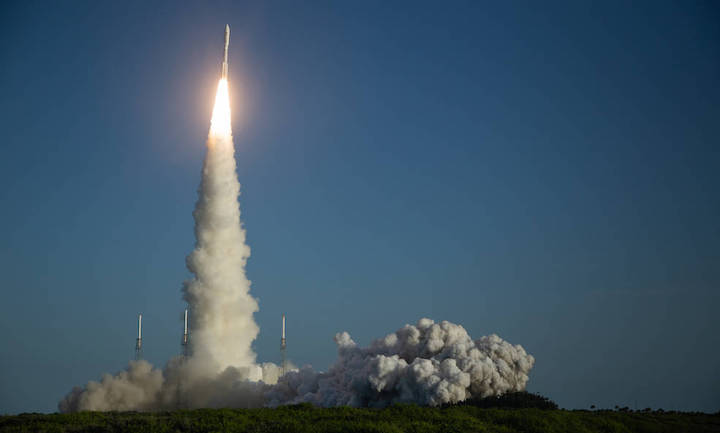
NASA's Mars 2020 Perseverance rover mission is on its way to the Red Planet to search for signs of ancient life and collect samples to send back to Earth.
Humanity's most sophisticated rover launched with the Ingenuity Mars Helicopter at 7:50 a.m. EDT (4:50 a.m. PDT) Thursday on a United Launch Alliance (ULA) Atlas V rocket from Space Launch Complex 41 at Cape Canaveral Air Force Station in Florida.
"With the launch of Perseverance, we begin another historic mission of exploration," said NASA Administrator Jim Bridenstine. "This amazing explorer's journey has already required the very best from all of us to get it to launch through these challenging times. Now we can look forward to its incredible science and to bringing samples of Mars home even as we advance human missions to the Red Planet. As a mission, as an agency, and as a country, we will persevere."
The ULA Atlas V's Centaur upper stage initially placed the Mars 2020 spacecraft into a parking orbit around Earth. The engine fired for a second time and the spacecraft separated from the Centaur as expected. Navigation data indicate the spacecraft is perfectly on course to Mars.
Mars 2020 sent its first signal to ground controllers via NASA's Deep Space Network at 9:15 a.m. EDT (6:15 a.m. PDT). However, telemetry (more detailed spacecraft data) had not yet been acquired at that point. Around 11:30 a.m. EDT (8:30 a.m. PDT), a signal with telemetry was received from Mars 2020 by NASA ground stations. Data indicate the spacecraft had entered a state known as safe mode, likely because a part of the spacecraft was a little colder than expected while Mars 2020 was in Earth's shadow. All temperatures are now nominal and the spacecraft is out of Earth's shadow.
When a spacecraft enters safe mode, all but essential systems are turned off until it receives new commands from mission control. An interplanetary launch is fast-paced and dynamic, so a spacecraft is designed to put itself in safe mode if its onboard computer perceives conditions are not within its preset parameters. Right now, the Mars 2020 mission is completing a full health assessment on the spacecraft and is working to return the spacecraft to a nominal configuration for its journey to Mars.
The Perseverance rover's astrobiology mission is to seek out signs of past microscopic life on Mars, explore the diverse geology of its landing site, Jezero Crater, and demonstrate key technologies that will help us prepare for future robotic and human exploration.
"Jezero Crater is the perfect place to search for signs of ancient life,” said Thomas Zurbuchen, associate administrator for NASA's Science Mission Directorate at the agency's headquarters in Washington. "Perseverance is going to make discoveries that cause us to rethink our questions about what Mars was like and how we understand it today. As our instruments investigate rocks along an ancient lake bottom and select samples to return to Earth, we may very well be reaching back in time to get the information scientists need to say that life has existed elsewhere in the universe."
The Martian rock and dust Perseverance’s Sample Caching System collects could answer fundamental questions about the potential for life to exist beyond Earth. Two future missions currently under consideration by NASA, in collaboration with ESA (European Space Agency), will work together to get the samples to an orbiter for return to Earth. When they arrive on Earth, the Mars samples will undergo in-depth analysis by scientists around the world using equipment far too large to send to the Red Planet.
An Eye to a Martian Tomorrow
While most of Perseverance's seven instruments are geared toward learning more about the planet's geology and astrobiology, the MOXIE (Mars Oxygen In-Situ Resource Utilization Experiment) instrument's job is focused on missions yet to come. Designed to demonstrate that converting Martian carbon dioxide into oxygen is possible, it could lead to future versions of MOXIE technology that become staples on Mars missions, providing oxygen for rocket fuel and breathable air.
Also future-leaning is the Ingenuity Mars Helicopter, which will remain attached to the belly of Perseverance for the flight to Mars and the first 60 or so days on the surface. A technology demonstrator, Ingenuity's goal is a pure flight test – it carries no science instruments.
Over 30 sols (31 Earth days), the helicopter will attempt up to five powered, controlled flights. The data acquired during these flight tests will help the next generation of Mars helicopters provide an aerial dimension to Mars explorations – potentially scouting for rovers and human crews, transporting small payloads, or investigating difficult-to-reach destinations.
The rover's technologies for entry, descent, and landing also will provide information to advance future human missions to Mars.
"Perseverance is the most capable rover in history because it is standing on the shoulders of our pioneers Sojourner, Spirit, Opportunity, and Curiosity," said Michael Watkins, director of NASA's Jet Propulsion Laboratory in Southern California. "In the same way, the descendants of Ingenuity and MOXIE will become valuable tools for future explorers to the Red Planet and beyond."
About seven cold, dark, unforgiving months of interplanetary space travel lay ahead for the mission – a fact never far from the mind of Mars 2020 project team.
"There is still a lot of road between us and Mars," said John McNamee, Mars 2020 project manager at JPL. "About 290 million miles of them. But if there was ever a team that could make it happen, it is this one. We are going to Jezero Crater. We will see you there Feb. 18, 2021."
The Mars 2020 Perseverance mission is part of America's larger Moon to Mars exploration approach that includes missions to the Moon as a way to prepare for human exploration of the Red Planet. Charged with sending the first woman and next man to the Moon by 2024, NASA will establish a sustained human presence on and around the Moon by 2028 through NASA's Artemis program.
JPL, which is managed for NASA by Caltech in Pasadena, California, built and will manage operations of the Mars Perseverance rover. NASA's Launch Services Program, based at the agency's Kennedy Space Center in Florida, is responsible for launch management, and ULA provided the Atlas V rocket.
Quelle: NASA
+++
NASA: Mars rover Perseverance in 'safe mode' after launch, but should recover
The rover was colder than expected after launch, NASA says.
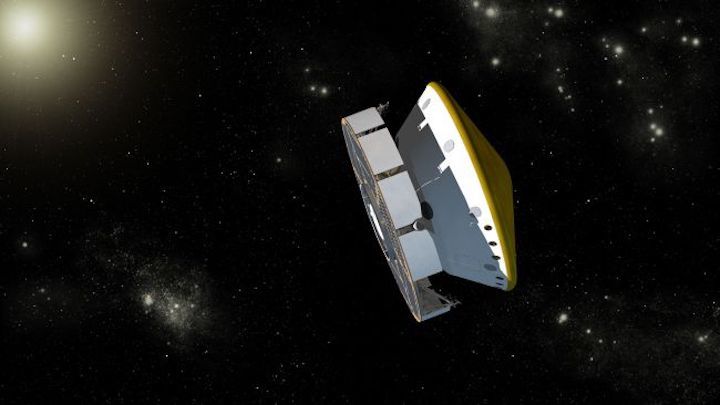
Update for July 31, 1:45 p.m. EDT: The Mars rover Perseverance is out of "safe mode" and is back to normal operations on its cruise to the Red Planet.
Original story:
NASA is celebrating the launch of its most advanced Mars rover ever today (July 30), even as engineers tackle a glitch that left the spacecraft in a protective "safe mode" shortly after liftoff.
The Mars 2020 Perseverance rover launched toward the Red Planet at 7:50 a.m. EDT (1150 GMT), riding an Atlas V rocket into space from Cape Canaveral Air Force Station in Florida. The rover experienced minor communications and temperature glitches after launch, but the issues aren't expected to harm the mission as a whole, NASA officials said.
"It was an amazing launch, right on time," NASA Administrator Jim Bridenstine said during a post-launch news conference. "I think we're in great shape. It was a great day for NASA."
Shortly after the conference, NASA confirmed that Perseverance slipped into "safe mode" due to an unexpected temperature difference.
"Data indicate the spacecraft had entered a state known as safe mode, likely because a part of the spacecraft was a little colder than expected while Mars 2020 was in Earth's shadow," NASA officials said in a statement. "All temperatures are now nominal and the spacecraft is out of Earth's shadow."
Post-launch hiccups
During today's post-launch news conference, the team received word that one issue, a lingering communications issue, was fixed. Within the first few hours after launch, although mission personnel could pick up the signal the spacecraft was sending home, it wasn't being processed correctly.
However, that situation didn't cause much concern, Matt Wallace, deputy project manager for Mars 2020 with NASA's Jet Propulsion Laboratory (JPL) in California, said during the briefing. The miscommunication was caused by the fact that NASA relies on a system called the Deep Space Network to communicate with Perseverance even soon after launch, when the spacecraft isn't yet all that deep into space.
And, because the Deep Space Network is made up of massive antennas equipped with super sensitive receivers, the signal from a spacecraft so close to the network can end up blasting the system, like someone screaming directly into your ear. Engineers needed to tweak the network settings in order to actually process the information coming from the spacecraft.
"Just as the administrator was speaking, I did just get a text that we were able to lock up on that telemetry," Wallace said. "All the indications that we have — and we have quite a few — are that the spacecraft is just fine."
NASA's Curiosity rover faced a similar issue during its launch in 2011, Wallace said. "It's something that we've seen before with other Mars missions," Bridenstine said. "This is not unusual. Everything is going according to plan."
Perseverance's 'safe mode' explained
The mission team revealed a second post-launch hiccup shortly later in the news conference: Perseverance went into safe mode.
When the spacecraft got a little colder than expected passing through Earth's shadow, it automatically put itself into that state, according to the NASA statement, although the spacecraft's temperature quickly bounced back and isn't concerning the team.
Wallace emphasized that such a status shouldn't harm the mission as a whole. Safe mode is, as the name implies, designed to be safe for the spacecraft to be in right now.
"The spacecraft is happy there," Wallace said. "The team is working through that telemetry, they're going to look to the rest of the spacecraft health. So far, everything I've seen looks good."
Later, Wallace told Space.com that the Perseverance mission team had traced the the temperature issue to the system that uses freon to keep the rover's nuclear battery cool.
Because Perserverance's launch carried it into Earth's shadow, it led to colder than expected temperatures in the cooling system, as compared to a launch in uninterrupted sunlight, Wallace told Space.com. When NASA's Curiosity rover, which has a similar nuclear battery, launched in 2011, it was always in daylight and did not experience the issue, he added.
"Unfortunately, our analysis is never really perfect," Wallace added. "Curiosity didn't have an eclipse in its flight trajectory so we didn't have flight data to know what was going to happen."
"The spacecraft was never in jeopardy," he continued. "Our philosophy is to be overly conservative on the parameters because we'd much rather trigger a safing event we didn't need, than miss a safing event we do need."
The team will continue to analyze the telemetry data that the vehicle has sent so far and double check that this is indeed the hiccup. Once that is complete, the team can put the rover back in an operational status.
Wallace said he expects for the spacecraft to return to normal operations mode tomorrow (July 31). But the team is not in any rush and are taking their time to carefully review all the data.
Perseverance is scheduled to fly straight and steady for the next at least two weeks, anyway, he said, and so the team has time to get the spacecraft back into normal operating mode before the first necessary trajectory adjustment of its journey.
The launch itself went smoothly, with an unusually quiet countdown in mission control rooms, despite an earthquake that rattled southern California, including NASA's Jet Propulsion Laboratory, about 20 minutes before the rocket fired in Florida.
Today's liftoff marked an important victory for the agency, which worried that measures imposed to reduce the spread of the coronavirus pandemic might slow launch preparations enough that Perseverance might miss its three-week window for a launch, which is dependent on orbital trajectories.
Another comparable opportunity wouldn't come again until 2022; if that 26-month delay had occurred, it would have cost the agency an extra $500 million, according to Bridenstine, on top of an already difficult mission.
"[It was] adversity all along the way, but this is true for any project of this nature," Bridenstine said of struggles before the pandemic, which included a cracked heat shield and the late addition of a complicated ride-along helicopter. "Then you put on top of that the coronavirus … I'm not gonna lie, it's a challenge. It's very stressful. But look, the teams made it happen."
But, despite earlier delays that pushed the launch more than a week into its window, the spacecraft blasted off during its first shot of its first countdown.
"It was truly a team effort. And in every single case, everyone stood up and said, 'Yes, we want to do what we can to help,'" Lori Glaze, director of the agency's planetary science division, said. "Somehow, we made it through this."
Now, the spacecraft and its human team back on Earth need to make it through a seven-month journey in deep space to reach the Red Planet. Once the spacecraft arrives at Mars, it will undergo the notoriously perilous process of entry, descent and landing.
That process will unfold on Feb. 18, 2021.
Quelle: SC
----
Update: 23.08.2020
.
Follow NASA's Perseverance Rover in Real Time on Its Way to Mars
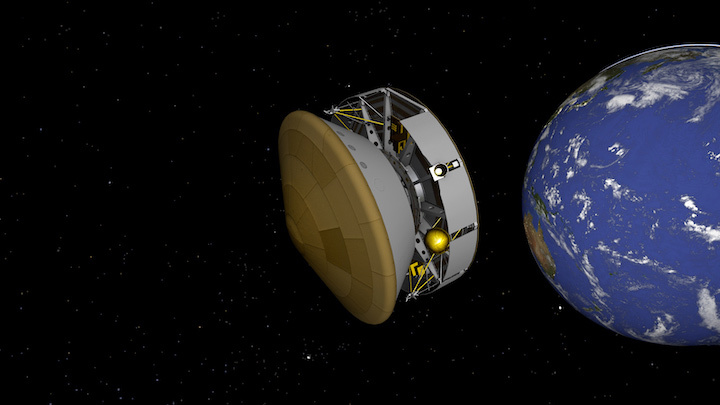
The Mars 2020 Perseverance mission lifted off from Cape Canaveral, Florida, on July 30. NASA's Eyes on the Solar System tool lets you track the spacecraft in real time as it makes its way to Mars for a Feb. 18, 2021, landing. Credit: NASA/JPL-Caltech
The last time we saw NASA's Mars 2020 Perseverance rover mission was on July 30, 2020, as it disappeared into the black of deep space on a trajectory for Mars. But with NASA's Eyes on the Solar System, you can follow in real time as humanity's most sophisticated rover - and the Ingenuity Mars Helicopter traveling with it - treks millions of miles over the next six months to Jezero Crater.
"Eyes on the Solar System visualizes the same trajectory data that the navigation team uses to plot Perseverance's course to Mars," said Fernando Abilleira, the Mars 2020 mission design and navigation manager at NASA's Jet Propulsion Laboratory in Southern California. "If you want to follow along with us on our journey, that's the place to be."
Give the Mars 2020 Perseverance spacecraft a spin. Fully interactive, Eyes on the Solar System doesn't just let you track it in real time as it travels to the Red Planet. Dozens of controls on pop-up menus allow you to customize not just what you see - from faraway to right "on board." Credit: NASA/JPL-Caltech
Eyes doesn't just let you see the distance between the Red Planet and the spacecraft at this very moment. You can also fly formation with Mars 2020 or check the relative velocity between Mars and Earth or, say, the dwarf planet Pluto.
"With all our orbital assets circling Mars as well as Curiosity and InSight on its surface, there is new data and imagery coming in all the time about the Red Planet," said Jon Nelson, visualization technology and applications development supervisor at JPL. "Essentially, if you haven't seen Mars lately through Eyes on the Solar System, you haven't seen Mars."
Dozens of controls on pop-up menus allow you to customize not just what you see - from faraway to right "on board" a spacecraft - but also how you see it: Choose the 3D mode, and all you need is a pair of red-cyan anaglyph glasses for a more immersive experience.
You don't have to stop at Mars, either. You can travel throughout the solar system and even through time. The website not only uses real-time data and imagery from NASA's fleet of spacecraft, it's also populated with NASA data going back to 1950 and projected to 2050. Location, motion, and appearance are based on predicted and reconstructed mission data.
While you're exploring, take a deeper dive into our home planet with Eyes on the Earth and travel to distant worlds with Eyes on ExoPlanets.
More About the Mission
Managed for NASA by JPL, a division of Caltech in Pasadena, California, the Mars 2020 Perseverance roveris part of a larger program that includes missions to the Moon as a way to prepare for human exploration of the Red Planet. Charged with returning astronauts to the Moon by 2024, NASA will establish a sustained human presence on and around the Moon by 2028 through NASA's Artemis lunar exploration plans.
Quelle: NASA
----
Update: 3.10.2020
.
You can track NASA's 2020 Mars rover Perseverance on its journey to the Red Planet
A new tool shows you Perseverance's deep-space location in real time.
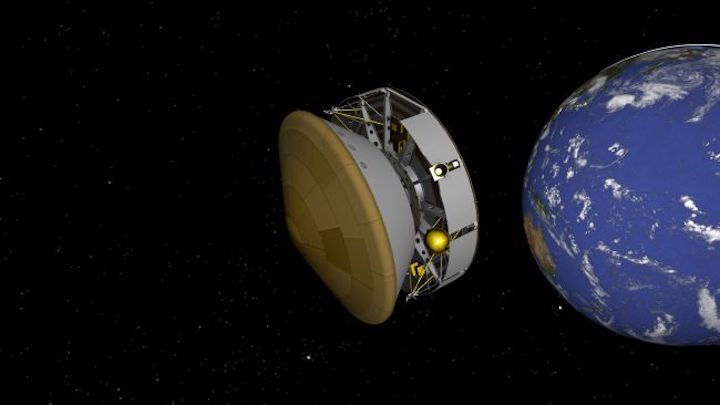
You can follow NASA's Mars 2020 Perseverance rover in real time as it makes its way to the Red Planet.
The interactive NASA web application Eyes on the Solar System shows you where Perseverance is as the rover travels millions of miles over the next few months. The rover, which launched on July 30, is scheduled to touch down inside Mars' Jezero Crater on Feb. 18, 2021.
"Eyes on the Solar System visualizes the same trajectory data that the navigation team uses to plot Perseverance's course to Mars," Fernando Abilleira, the Mars 2020 mission design and navigation manager at NASA's Jet Propulsion Laboratory (JPL) in Southern California, said in a statement. "If you want to follow along with us on our journey, that's the place to be."
Using the app, which you can find here, you can track the remaining distance between Perseverance and Mars at any time, view Perseverance up close and compare the spacecraft's size to that of other NASA probes, such as Juno, Voyager 1 or the Parker Solar Probe. You can also fly in formation with Perseverance or check the relative velocity between Earth and Mars or other objects like the dwarf planet Pluto, according to the statement.
"With all our orbital assets circling Mars as well as Curiosity and InSight on its surface, there is new data and imagery coming in all the time about the Red Planet," Jon Nelson, visualization technology and applications development supervisor at JPL, said in the same statement. "Essentially, if you haven't seen Mars lately through Eyes on the Solar System, you haven't seen Mars."
After Perseverance lands, the rover will hunt for signs of habitable environments on Mars and search for signs of past microbial life. The rover is also designed to collect a series of samples that can be returned to Earth with a future mission and carries the Mars Helicopter, named Ingenuity, which will be the first rotary craft to fly on another planet.
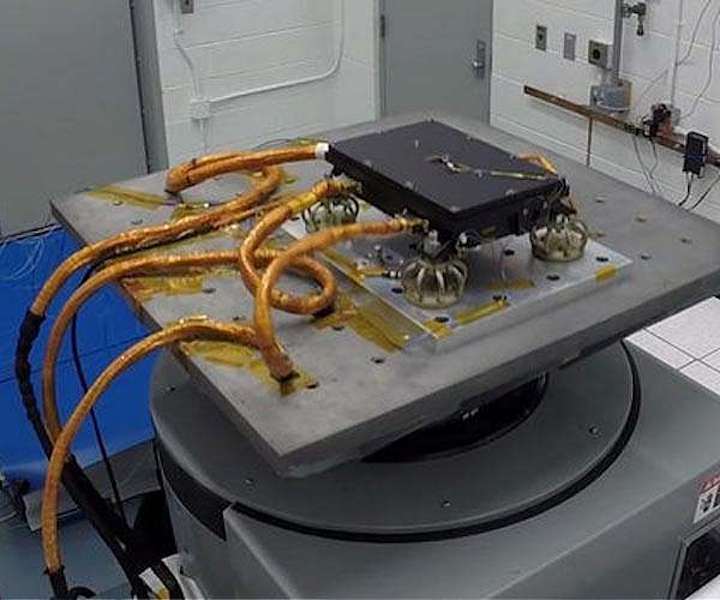
On Oct. 8, 2020, with COVID-19 safety protocols in place, team members of the Mars 2020 Perseverance rover mission waited for a reply from the Mars Entry, Descent, and Landing Instrumentation 2 (MEDLI2) suite onboard the spacecraft, which is currently en route to the Red Planet.
MEDLI2 is a collection of sensors that will measure aerothermal environments and thermal protection system material performance during the atmospheric entry phase of the Mars 2020 mission.
The sensors successfully passed a battery of environmental tests before being installed on the Mars 2020 heat shield and backshell to ensure they could withstand launch and the harsh conditions of space.
During the recent MEDLI2 cruise checkout, the team at the Flight Mission Support Center at NASA's Langley Research Center in Hampton, Virginia, received data back from the spacecraft for the first time since the rover launched in July.
"This is the first time MEDLI2 has been tested since before launch," said Henry Wright, MEDLI2 project manager. "The test went great; we got the data we wanted, and everything looks like we predicted it would."
The test ensured that sensors and electronics powered on successfully and pressure and temperature sensors were measuring as expected.
"With this verification that MEDLI2 survived launch and the cold of deep space, the team is excited to support the Perseverance rover's landing in February," Wright added.
MEDLI2 is a Game Changing Development project led by NASA's Space Technology Mission Directorate with support from the Human Exploration and Operations Mission Directorate and Science Mission Directorate. The project is managed at Langley and implemented in partnership with NASA's Ames Research Center in California's Silicon Valley and NASA's Jet Propulsion Laboratory in Southern California.
A key objective of Perseverance's mission on Mars is astrobiology, including the search for signs of ancient microbial life. The rover will characterize the planet's geology and past climate, pave the way for human exploration of the Red Planet, and be the first mission to collect and cache Martian rock and regolith (broken rock and dust).
Subsequent missions, currently under consideration by NASA in cooperation with the European Space Agency, would send spacecraft to Mars to collect these cached samples from the surface and return them to Earth for in-depth analysis.
The Mars 2020 mission is part of a larger program that includes missions to the Moon as a way to prepare for human exploration of the Red Planet. Charged with returning astronauts to the Moon by 2024, NASA will establish a sustained human presence on and around the Moon by 2028 through NASA's Artemis lunar exploration plans.
Quelle: SD
----
Update: 30.10.2020
.
NASA's Mars rover Perseverance is halfway to the Red Planet
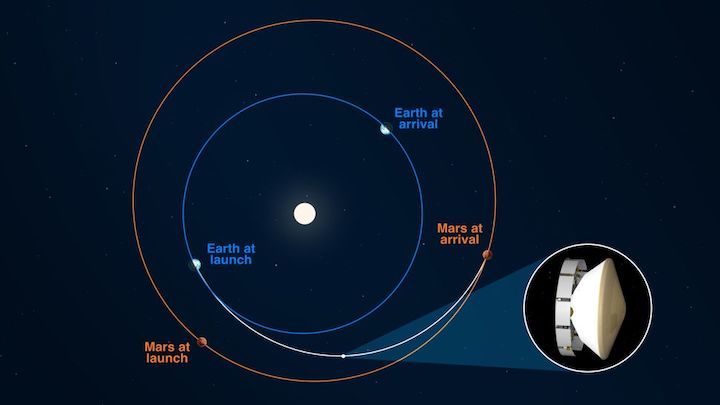
NASA's next Mars rover is halfway to its otherworldly destination.
The Mars 2020 rover Perseverance, which launched on July 30, has now traveled 146 million miles (235 million kilometers) in deep space — half of the total required to reach the Red Planet, mission team members announced Tuesday (Oct. 27).
"While I don't think there will be cake, especially since most of us are working from home, it's still a pretty neat milestone," Julie Kangas, a mission navigator at NASA's Jet Propulsion Laboratory (JPL) in Southern California, said in a statement Tuesday. "Next stop, Jezero Crater."
The 28-mile-wide (45 km) Jezero, where Perseverance will touch down on Feb. 18, hosted a lake and a river delta in the ancient past. The car-size rover will characterize the area's geology and climate in detail and search for possible signs of long-dead life, among other tasks.
Perseverance will also collect and cache several dozen samples from the Martian terrain for future return to Earth. The return campaign, a joint NASA-European Space Agency effort, could get this precious Mars material here as early as 2031.
In addition, Perseverance carries on its belly a small helicopter named Ingenuity, a demonstration craft designed to help pave the way for extensive rotorcraft exploration of Mars in the future.
The rover reached the exact halfway point in its interplanetary journey — 146.3 million miles (235.4 million km) — at 4:40 p.m. EDT (2040 GMT) Tuesday, NASA officials said. But Perseverance is taking a curving route to Mars, so the spacecraft is not midway between the two planets as the space-crow flies.
"In straight-line distance, Earth is 26.6 million miles [42.7 million km] behind Perseverance and Mars is 17.9 million miles [28.8 million km] in front," Kangas said.
The Perseverance team hasn't been sitting on its hands during the mission's current "cruise phase." Over the past two weeks, for example, team members have performed checkouts of four different rover instruments. Everything is working well, NASA officials said.
"If it is part of our spacecraft and electricity runs through it, we want to confirm it is still working properly following launch," mission deputy chief engineer Keith Comeaux, also of JPL, said in the same statement.
"Between these checkouts — along with charging the rover's and Mars Helicopter's batteries, uploading files and sequences for surface operations, and planning for and executing trajectory correction maneuvers — our plate is full right up to landing," Comeaux said.
NASA Invites Media to Briefing on Mars Sample Return Independent Review Board Report
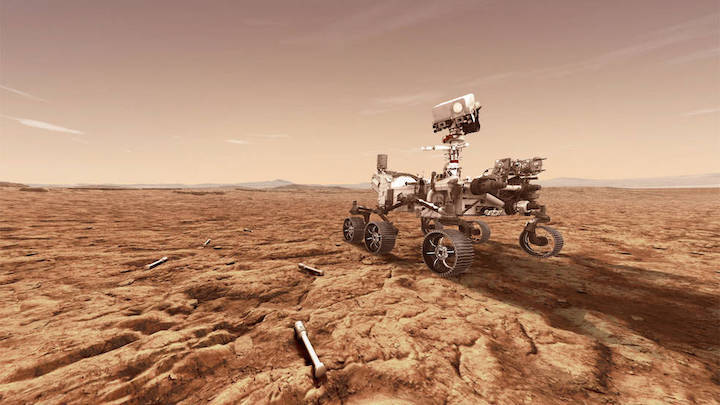
NASA's Mars 2020 Perseverance rover will store rock and soil samples in sealed tubes on the planet's surface for future missions to retrieve, as seen in this illustration.
Credits: NASA/JPL-Caltech
NASA will host a media teleconference at 11 a.m. EST Tuesday, Nov. 10, to discuss the findings and recommendations of the report by an agency-commissioned independent board about NASA’s plans with ESA (European Space Agency) for a Mars Sample Return mission.
NASA established the Mars Sample Return (MSR) Independent Review Board (IRB) to evaluate the agency’s early concepts for an international partnership with ESA to return the first samples from another planet. The report will be released at 9 a.m. Tuesday, Nov. 10, on the agency’s Reports and Transcripts webpage and includes the MSR IRB’s findings and recommendations and NASA’s responses.
During the teleconference, NASA science leadership and MSR IRB members will discuss the IRB’s findings and recommendations for the agency’s MSR architecture and what the next steps are for NASA to pursue the ambitious endeavor to collect and return pristine samples from Mars to the Earth.
Quelle: NASA
----
Update: 29.12.2020
.
Marvels of engineering, the rover's sample tubes must be tough enough to safely bring Red Planet samples on the long journey back to Earth in immaculate condition.
The tubes carried in the belly of NASA's Mars 2020 Perseverance rover are destined to carry the first samples in history from another planet back to Earth. Future scientists will use these carefully selected representatives of Martian rock and regolith (broken rock and dust) to look for evidence of potential microbial life present in Mars' ancient past and to answer other key questions about Mars and its history. Perseverance will land at Mars' Jezero Crater on Feb. 18, 2021.
About the size and shape of a standard lab test tube, the 43 sample tubes headed to Mars must be lightweight and hardy enough to survive the demands of the round trip, and so clean that future scientists will be confident that what they're analyzing is 100% Mars.
"Compared to Mars, Earth is filled with evidence of the life that covers our planet," said Ken Farley, the Mars 2020 project scientist at Caltech in Pasadena. "We needed to remove those signs so thoroughly that any scant evidence remaining can be confidently detected and differentiated when these first samples are returned."
The practice of engineering containers to ferry samples from other worlds goes back to Apollo 11. When Neil Armstrong, Michael Collins, and Buzz Aldrin returned to Earth with 47.7 pounds (21.8 kilograms) of samples from the Moon's Sea of Tranquility in 1969, they carried them in two triple-sealed, briefcase-size aluminum boxes. But Apollo's rock boxes needed to keep their cargo pristine only for about 10 days – from the lunar surface to splashdown – before being whisked off to the Lunar Receiving Laboratory. Perseverance's sample tubes must isolate and preserve the scientific value of their contents for well over 10 years.
Mars Sample Return
As NASA's newest rover investigates Jezero Crater, mission scientists will determine when and where it will drill for samples. This precious Martian cargo will be packaged in those tubes with the most intricate and technologically advanced mechanism ever sent into space: the Sample Caching System. After the samples have been deposited on the Martian surface, two other missions being formulated by NASA in partnership with ESA (the European Space Agency) will complete the relay to get them back to Earth.
The second mission in this sample return campaign will send a "fetch" rover to retrieve the hermetically-sealed tubes and deliver them to a special sample return container inside the Mars Ascent Vehicle. The Mars 2020 Perseverance rover could also deliver tubes with samples to the vicinity of the Mars Ascent Vehicle if it remains healthy well into an extended mission. The Mars Ascent Vehicle will then launch the tubes into orbit.
The final mission will fly an orbiter to Mars to rendezvous with the encapsulated samples, capture them in a highly secure containment capsule, and ferry them back to Earth (as early as 2031).
Robust Containers
Made chiefly of titanium, each sample tube weighs less than 2 ounces (57 grams). A white exterior coating guards against heating by the Sun potentially changing the chemical composition of the samples after Perseverance deposits the tubes on the surface of Mars. Laser-etched serial numbers on the exterior will help the team identify the tubes and their contents.
Each tube must fit within the tight tolerances not only of Perseverance's Sample Caching System, but those of the future missions.
"They are less than 6 inches [15.2 centimeters] long, but we still found over 60 different dimensions to scrutinize," said Sample Tube Cognizant Engineer Pavlina Karafillis of JPL. "Because of the intricacies of all the complex mechanisms they will pass through during the Mars Sample Return campaign, if any measurement was off by about the thickness of a human hair, the tube was deemed not suitable for flight."
100% Pure Jezero
Precision engineering is only part of the challenge. The tubes are also the product of extreme cleanliness standards. All of NASA's planetary missions involve exacting processes to prevent the introduction of Earthly organic, inorganic, and biological material. But since these tubes could hold proof that life once existed elsewhere in the universe, the Mars 2020 team needed to reduce – even further – the possibility that they could host Earthly artifacts that could complicate the scientific process. The mandate was essentially that nothing should be in a tube until the Sample Caching System begins filling it with 9 cubic inches (147 cubic centimeters) of Jezero Crater (about the size of a piece of chalk).
"And when they said 'nothing,' they meant it," said Ian Clark, the mission's assistant project systems engineer for sample tube cleanliness at JPL. "An example: To achieve the kind of science the mission is going after, we needed to limit the total amount of Earth-based organic compounds in a given sample to less than 150 nanograms. For a set of particular organic compounds – ones that are very indicative of life – we were limited to less than 15 nanograms in a sample."
A nanogram is a billionth of a gram. An average thumbprint carries about 45,000 nanograms of organics – about 300 times the total allowed in a sample tube. To meet such stringent mission specifications, the team had to rewrite the book on cleaning.
"We did all our assembly in a hyper-clean-room environment, which is essentially a clean room inside a clean room," said Clark. "Between assembly steps, the sample tubes would be cleaned with filtered air blasts, rinsed with deionized water, and sonically cleaned with acetone, isopropyl alcohol, and other exotic cleaning agents."
After each cleaning, the team would measure contaminants and bake the tubes for good measure. By the time the 43 sample tubes were selected from a field of 93 fabricated for flight, each had generated over 250 pages of documentation and 3 gigabytes of images and videos.
Of the tubes aboard Perseverance, up to 38 are destined to be filled with Martian rock and regolith. The other five are "witness tubes" that have been loaded with materials geared to capture molecular and particulate contaminants. They'll be opened one at a time on Mars to witness the ambient environment primarily near sample collection sites, cataloging any Earthly impurities or contaminants from the spacecraft that may be present during sample collection.
The the sample and witness tubes' eventual return to and examination on Earth will allow the full breadth of terrestrial science laboratory capabilities to investigate the samples, using instruments too large and complex to send to Mars.
More About the Mission
A key objective of Perseverance's mission on Mars is astrobiology, including the search for signs of ancient microbial life. The rover will characterize the planet's geology and past climate, pave the way for human exploration of the Red Planet, and be the first mission to collect and cache Martian rock and regolith (broken rock and dust).
Subsequent missions, currently under consideration by NASA in cooperation with ESA (European Space Agency), would send spacecraft to Mars to collect these cached samples from the surface and return them to Earth for in-depth analysis.
The Mars 2020 mission is part of a larger program that includes missions to the Moon as a way to prepare for human exploration of the Red Planet. Charged with returning astronauts to the Moon by 2024, NASA will establish a sustained human presence on and around the Moon by 2028 through NASA's Artemis lunar exploration plans.
JPL, which is managed for NASA by Caltech in Pasadena, California, built and manages operations of the Perseverance rover.
Quelle: NASA






